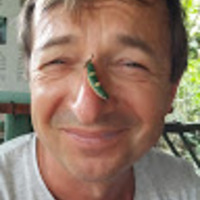Papers by Damayanti Buchori
Nature, May 24, 2023
alters the functioning of ecological communities and environmental conditions, leading to a reduc... more alters the functioning of ecological communities and environmental conditions, leading to a reduction of several ecosystem functions and services 7,8. Many agricultural landscapes are in urgent need of ecological restoration to safeguard biodiversity and ecosystem functioning while also promoting local livelihoods 9-11 , a central goal of the current United Nations decade on Ecosystem Restoration. However, trade-offs between biodiversity or ecosystem functioning and agricultural productivity may result in failed restoration efforts or lead to undesirable ecological spillover effects by promoting the expansion of the agricultural frontier into natural forested areas 12. One way to mitigate

Biotropia: The Southeast Asian Journal of Tropical Biology, Dec 30, 2002
Random amplified polymorphic DNA (RAPD) amplified by the polymerase chain reaction (PCR) was used... more Random amplified polymorphic DNA (RAPD) amplified by the polymerase chain reaction (PCR) was used to determine the differences of four Telenomus species and five populations of T. rowani from several locations in Java. Amplification of genomic DNA by using primer P2 (Amersham Pharmacia Biotech) indicated that each Telenomus species had a unique set of RAPD bands. Two bands which characterized the genus are estimated to be 300 and 430 bp. Each species had three specific bright bands except T. dignoides which only had two specific bright bands. However, no bands are unique to any of the five populations of T. rowani and all of the bands are less than 500 base-pair. Cluster analysis using UPGMA (Unweighed Pair Group Method With Arithmatic Mean) showed that the four Telenomus species consist of two groups, T. rowani and T. remus in one cluster and T. dignus with T. dignoides belonging to another cluster.

Jurnal Entomologi Indonesia, Jul 31, 2012
Deforestation has a negative impact toward ecosystem and diversity. Landuse change has been known... more Deforestation has a negative impact toward ecosystem and diversity. Landuse change has been known to negatively impact insect like ant and beetle in Jambi Province. This research aims to study the diversity, abundance, and composition of the leaf beetle in the Bukit Duabelas National Park (TNBD) and Harapan Forest landscape. Insect sampling was carried out using canopy fogging method. Four core plots were determined in each land use (as replicates) and each plot consist of three as subplot. Insect was collected in 16 traps (size 1 m x 1 m) that was installed under plant canopy prior to fogging process. The collected sample was sorted and identified in the Biocontrol Laboratory, Plant Protection Department, Faculty of Agriculture, IPB University. Total of 1,040 individuals leaf beetles were collected, belonging to 6 subfamilies and 127 morphospecies. The result of this research showed that a different lanscape has no effect give impact to insect abundance. Different landuse however does significantly impact the abundance and diversity of leaf beetle (Coleoptera: Chrysomelidae).

Jurnal Entomologi Indonesia, Dec 9, 2018
ABSTRAK Famili Curculionidae termasuk kelompok kumbang (Ordo Coleoptera) yang memiliki peranan pe... more ABSTRAK Famili Curculionidae termasuk kelompok kumbang (Ordo Coleoptera) yang memiliki peranan penting dalam berbagai ekosistem baik hutan, perkebunan, dan pertanian lainnya. Perubahan tipe penggunaan lahan dari hutan menjadi lahan pertanian dapat menyebabkan penurunan keanekaragaman kumbang curculionid. Penelitian ini bertujuan untuk memelajari kekayaan spesies dan kelimpahan kumbang curculionid berdasarkan musim dan tipe penggunaan lahan di kawasan Hutan Harapan, Jambi. Koleksi kumbang curculionid dilakukan dengan metode pengasapan (fogging) kanopi. Penelitian dilakukan pada empat tipe penggunaan lahan, yaitu hutan, hutan karet, perkebunan karet, dan perkebunan kelapa sawit pada musim kemarau (bulan Mei hingga September 2013) dan musim hujan (bulan November 2013 hingga Februari 2014). Total jumlah serangga curculionid yang ditemukan 1762 individu, 12 subfamili, dan 118 spesies kumbang curculionid. Spesies kumbang curculionid tertinggi ditemukan di hutan (81 spesies) dan terendah di perkebunan karet (20 spesies). Kumbang curculionid dominan yang ditemukan di setiap tipe penggunaan lahan, yaitu Curculioninae sp.21 (hutan), Entiminae sp.06 (hutan karet), Scolytinae sp.09 (perkebunan karet), dan Elaeidobius kamerunicus Faust (perkebunan kelapa sawit). Jumlah individu curculionid tertinggi ditemukan di perkebunan kelapa sawit (853 individu) dan terendah di perkebunan karet (33 individu). Tipe penggunaan lahan dan keanekaragaman vegetasi tumbuhan memengaruhi kekayaan spesies curculionid, tetapi tidak memengaruhi kelimpahan kumbang curculionid. Berdasarkan hasil analisis menunjukkan bahwa perbedaan musim memengaruhi komposisi spesies kumbang curculionid pada tipe penggunaan lahan hutan, sedangkan pada tipe penggunaan lahan hutan karet, perkebunan karet, dan perkebunan kelapa sawit tidak menunjukkan perbedaan.

IOP Conference Series: Earth and Environmental Science
Eucalyptus (Myrtaceae) is planted to produce materials such as paper, pulp, viscose, and wood. Th... more Eucalyptus (Myrtaceae) is planted to produce materials such as paper, pulp, viscose, and wood. The eucalyptus gall wasp, Ophelimus eucalypti (Gahan) (Hymenoptera: Eulophidae), induces the formation of galls on the leaves of Eucalyptus in North Sumatra, Indonesia. However, the identity of parasitoids associated with O. eucalypti in the field is poorly known. The study aimed to identify the parasitoids and their most prevalent species associated with O. eucalypti. Leaves of Eucalyptus with parasitized galls were sampled from January to October 2021 at Toba, North Tapanuli, and Samosir districts, North Sumatra. The collected material was incubated in the laboratory until gall wasp adults for its parasitoids emerged. Nine hymenopteran parasitoids of O. eucalypti were recovered and identified via analysis of the external morphology. They are Aprostocetus causalis La Salle & Wu, Aprostocetus Westwood sp., Chrysonotomyia germanica Erdös, Chrysonotomyia Ashmead sp. 1, Chrysonotomyia sp. 2, ...

IOP Conference Series: Earth and Environmental Science
Biological control research in Indonesia has a long history since it was started by Dutch scienti... more Biological control research in Indonesia has a long history since it was started by Dutch scientists more than 100 years ago. Currently, the number of research has arisen, but there has been no systematic analysis of how this research produces technology that can be practiced in the field. This analysis is essential since it provides baseline information about biocontrol research and provides future research direction. This study aims to conduct a systematic review of biocontrol research conducted in Indonesia over the past 20 years. All articles were obtained from various databases using keywords related to biocontrol. A total of 437 articles were analyzed. We focussed our research on predators and parasitoids and found 269 articles related to parasitoids and predators. We found that biocontrol research in Indonesia was dominated by research on insect pathogens. Further analyses showed that research on identification and biology dominated most of the studies on predators and parasi...

Insects
Wolbachia-infected Aedes aegypti is the latest technology that was developed to eliminate dengue ... more Wolbachia-infected Aedes aegypti is the latest technology that was developed to eliminate dengue fever. The Ministry of Research and Technology of the Republic of Indonesia (Kemenristekdikti) established an expert group to identify future potential risks that may occur over a period of 30 years associated with the release of Wolbachia-infected Ae. aegypti. The risk assessment consisted of identifying different hazards that may have impacts on humans and the environment. From the consensus among the experts, there were 56 hazards identified and categorized into 4 components, namely, ecological matters, efficacy in mosquito management, economic and sociocultural issues, and public health standards. There were 19 hazards in the ecological group. The overall likelihood in the ecology of the mosquito is very low (0.05), with moderate consequence (0.74), which resulted in negligible risk. For the efficacy in mosquito management group, there were 12 hazards that resulted in very low likeli...

Indonesia is known to be the home of an incredibly biodiverse fauna, with thousands and thousands... more Indonesia is known to be the home of an incredibly biodiverse fauna, with thousands and thousands of amazing animal species. This is particularly true for the Arthropoda, which is the phylum of multi-legged invertebrates such as insects, spiders, scorpions, centipedes, and millipedes. Despite continuous taxonomic efforts to systematically describe and name newly discovered species, most Indonesian arthropods remain unknown to science. This book, as a product of the intensive collaboration between the Department of Plant Protection at IPB University and the Department of Animal Ecology at University of Göttingen within the EFForTS project, is aimed at the nexus between ecological research and taxonomical discovery. Through cooperative publication with BRIN Publishing, this book focuses on four major beetle families from Jambi Province in the heart of Sumatra, containing ecological background, identification keys to subfamily and genera, and a photographic collection of more than 500...

Ants are tiny creatures that are often overlooked in our everyday lives. Yet, there are more than... more Ants are tiny creatures that are often overlooked in our everyday lives. Yet, there are more than 15.000 species of ants on Earth, and their total biomass is higher than that of all humans combined. They invented agriculture more than 50 million years ago, turn more soil than earthworms, can lift 5,000 times their bod weight, and can form supercolonies that span across continents. With the third largest tropical forest in the world, Indonesia is home to thousands of ant species, many of them unknown to science. This book documents more than 300 ant species that were found in rainforests and agroforestry of Jambi Province, Sumatra, and includes a recently updated Identification Key to the ant genera of Southeast Asia. Studying this book will bring you closer to our planet’s fascinating diversity, and the little things that run our world. This book will be a great starting point for those who want to know more about the ants of Southeast Asia, as well as a valuable resource for scient...

Ecosphere, 2021
The conversion of natural ecosystems to agricultural land is one of the most important drivers of... more The conversion of natural ecosystems to agricultural land is one of the most important drivers of biodiversity decline worldwide, particularly in the tropics. Species loss is typically trait‐associated, leading to filtering of disturbance‐resistant species during community assembly, which affects ecosystem functioning and evolutionary potential of communities. To understand the ecological and phylogenetic impact of rainforest conversion to agricultural systems, we combine analysis of nesting habit, feeding habit, colony size, and body size of canopy ants (Formicidae) with a phylogenetic analysis of species collected in four land‐use systems in Sumatra, Indonesia: (1) lowland tropical rainforest, (2) jungle rubber (extensive rubber agroforest), and smallholder plantations of (3) rubber and (4) oil palm. Canopy ant communities in these land‐use systems differed in trait composition, with a larger proportion of generalist nesting and generalist‐omnivore feeding species in oil palm comp...

IOP Conference Series: Earth and Environmental Science, 2020
The convertion of forest functions to oil palm plantations has an impact on biodiversity. One of ... more The convertion of forest functions to oil palm plantations has an impact on biodiversity. One of the impacts of biodiversity may affect the butterflies diversity. This research was conducted in one of the oil palm areas in PT. Humusindo in Jambi. The purpose of this study were to determine the diversity and active time of butterflies in oil palm plantations of PT. Humusindo Jambi. The study was conducted for 2 months. Sampling method used for this research were scan sampling in the oil palm plantation area by capturing using insect nets. Butterflies are captured using insect nets then counted, marked (to avoid repeated calculations) and released again. Observation separated per one hour starting at 08.00 am to 04.59 pm. The results showed the highest diversity index of butterflies found was at 13.00-13.59 (H’=2.39) with total species number was 34 species. Overall, the butterfly diversity index found was relatively low (H’=1.78) with total species number was 54 species. The most dom...

IOP conference series, Sep 19, 2019
Elaeidobius kamerunicus is a well-known insect pollinator of oil palm. The presence of E. kamerun... more Elaeidobius kamerunicus is a well-known insect pollinator of oil palm. The presence of E. kamerunicus directly creates sustainability in oil palm plantations and successfully increase palm oil production in Indonesia. However, recent reports showed that there are morphometric differences across islands that might be due to different selection pressures that might influence the genetic diversity of the weevil. The aim of this research is to study and analyze E. kamerunicus genetic diversity from various locations in Indonesia. Samples were taken using a purposive sampling method from post-anthesis male flowers from 16 regions oil palm centers in Indonesia. Insect DNA amplified by PCR technique using 11 SSR primer. The results showed that some of the SSR markers used were polymorphic. The highest percentage of polymorphic loci is the population of Central Kalimantan, West Java, and Papua. The Population of E. kamerunicus in Indonesia has a close relationship and most of the population does not result from inbreeding. Phylogenetic tree constructed using DARwin formed three groups containing mixtures of five spatial distribution regions (islands). The high PIC value and the formation groups indicate the high genetic diversity of E. kamerunicus in Indonesia.

IOP conference series, Mar 1, 2020
Cattle grazing activity in oil palm plantation is known to cause the loss of non-crop vegetation ... more Cattle grazing activity in oil palm plantation is known to cause the loss of non-crop vegetation and may affect species richness and abundance of predatory insect. The objective of this research was to study the effect of regeneration time after grazing on species richness, abundance, and species composition of predatory insects in oil palm-cattle integrated plantation. Predatory insects were collected from 3 grazed blocks and 3 ungrazed blocks of oil palm plantation. The observations were conducted at 4 periods i.e. 1 day before cattle grazing activity, 30 d after grazing, 60 d after grazing, and 90 d after grazing. The result of this research showed that regeneration time after cattle grazing activity does not affect species richness but caused a decrease in abundance and changes in species composition of Reduviidae at 30 d after grazing. The most dominant morphospecies are Cosmolestes sp. and Reduviidae sp. 4. Recovery of understorey vegetation after 90 d provide a stable ecosystem for Reduviidae recolonization.

IOP Conference Series: Earth and Environmental Science
The diversity of hymenopteran parasitoid wasps is influenced by the presence of the host, the num... more The diversity of hymenopteran parasitoid wasps is influenced by the presence of the host, the number and type of flowering vegetation as a food source for adult parasitoids. This study aims to determine the effect of reducing non-crop vegetation by cattle grazing disturbances on the impact of beneficial ecosystem services, especially parasitoids wasp in oil palm plantations. This disturbance phenomenon is important to study, so that it can see the response of each parasitoid wasp due to reduced vegetation and become the basis for strategies for habitat enrichment in oil palm plantations. Sampling was carried out in six blocks, including six oil palm blocks consisting of three blocks with non-plant vegetation disturbance and three blocks without disturbance. Insect collection uses yellow pot traps, malaise traps, and sweeping nets. In total, 4273 individuals belonging to 185 morphospecies, 24 families, and 9 superfamilies were collected from all sampling methods. The diversity and ab...

Indonesian Society for Biology and Department of Biology, Faculty of Mathematics and Natural Science, 2005
The functional response of the parasitoid Eriborus argenteopilosus (Cameron) (Hymenoptera: Ichneu... more The functional response of the parasitoid Eriborus argenteopilosus (Cameron) (Hymenoptera: Ichneumonidae) were studied using Crocidolomia pavonana (Fabricius) (Lepidoptera: Pyralidae) larvae as host at different densities. All larvae were exposed to one E. argenteopilosus female for three hours at three different temperatures, i.e 20 o C, 25 o C, and 30 o C. Data were analyzed using logistic regression to determine the type of functional response. At 20 o C E. argenteopilosus showed type II functional response, while at 25 o C and 30 o C the functional response is type III. Based on surface analysis, the optimal parasitism rate occurred at 22.24 o C with 10.12 larvae parasitized/hour. The larvae density to achieve optimal parasitism rate was 69.38 larvae. The optimal oviposition rate was 12.59 eggs/hour which occurred at 24.41 o C, using a density of 94.54 larvae.

IOP Conference Series: Earth and Environmental Science, 2021
Fall armyworm (FAW) Spodoptera frugiperda is an invasive pest that enters Indonesia which can pos... more Fall armyworm (FAW) Spodoptera frugiperda is an invasive pest that enters Indonesia which can pose a serious threat to the continued production of maize and other crops. This condition is exacerbated if there are no natural enemies who can control the pests. This study aims to explore potential native natural enemies to control the population of FAW in Indonesia and the influence of habitat conditions on the distribution and population of natural enemies. The research was conducted in seven sub-districts in Bogor and three plots were selected from each district. Observation of natural enemies was carried out directly by collecting samples of eggs and larvae of FAW which attacked maize with the transect method on 200 individual plants. The samples collected will be rearing until the parasitoids emerged. We Collected seven genera of parasitoids that were associated with FAW: Apanteles, Charops, Euplectrus, Microplitis, Telenomus, Trichogramma, and two types of predators: ground beetle...











Uploads
Papers by Damayanti Buchori